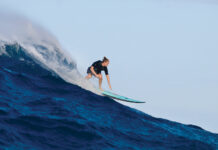A true professional, Kai makes it look easy. But behind every fluid glide and carve are years of experience, natural talent, and a healthy dose of stubbornness.
“When Kai first asked me to make him a [standup paddleboard hydrofoil], I was like, ‘It might work, but I’m not really sure if it will.’ But he was persistent,” recalls Alex, who began developing the technology in early 2015.
Alex’s background as a professional windsurfer, coupled with years of kiteboarding and hydrofoil building, are part of the equation. Kai’s ability to read the currents and master any kind of board he steps onto is the second piece.
“He’s the best standup paddle foil rider I know, so it’s like this dream team,” says Alex, who has been creating boards and foils longer than Kai has been alive. “I make the thing, and Kai makes it work.”
Earlier this year, Kai released a video that shows him soaring above the water on the standup hydrofoil, and onlookers from around the world went crazy. Within days, the post amassed millions of views, thousands of comments, and even a few doubters who questioned the video’s authenticity.
“When the video came out, there were people saying, ‘Oh, that’s hydrodynamically impossible,’ or, ‘He must’ve been towed by a Jet Ski.’ Somebody even called it sorcery,” grins Kai. “When something isn’t proven, it’s hard for people to imagine how it could work. Now that we’ve proven it does work, I’m hoping that more people get into it and start pushing the sport even further.”
Kai has been working with Naish to develop another version of standup paddleboard hydrofoil named—you guessed it—the Malolo.
He predicts that within a decade, the equipment will put today’s prototype to shame. “It’s going to be so dialed in and perfect that we’re going to look back on this and think, ‘Gosh, this stuff was ancient.’”
Standup paddle hydrofoils will be available to the public Fall 2016 at NaishSurfing.com and GoFoil.com.

Think of the hydrofoil as a kind of underwater airplane, and the water around it as the air. Like a plane’s wing, the front foil wing is curved on top, flat underneath, giving the top more surface area than the bottom. The greater surface area makes water travel faster over the top, and that creates higher pressure under the wing, lower pressure above. Once the board has built enough speed for “takeoff,” that higher pressure tilts the board upwards and generates lift. But staying up isn’t so simple. The key is to use your body’s weight to balance the foil wing about six inches below the surface of the water. Weight forward makes the foil go down; weight back makes it rise . . . and if the wings reach the surface, you could lose lift and slam back into the water.





